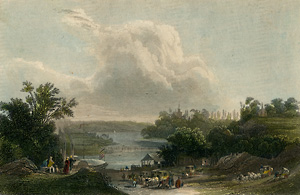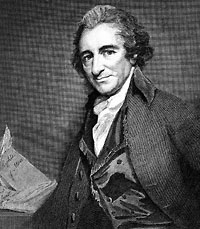Bordentown, NJ | View Map

View on the Delaware near Bordentown, Karl Bodmer, 1832. A coach and delivery wagon are hurrying to meet the steamboat docked at the Bordentown landing. Bodmer, a Swiss artist, painted this scene near the Bonaparte estate. Period guidebooks often included the country estates of famous people. Credit: The Library of Congress, Prints and Photographs Collection
Although its total area is less than one square mile, the small city of Bordentown holds a significant place in the cultural and commercial history of New Jersey. Located between Trenton and Philadelphia on a bluff overlooking a bend in the Delaware River, Bordentown has long been a transportation hub. English Quaker Thomas Farnsworth moved from Burlington to settle here in 1682 and “Farnsworth Landing” became a thriving trading post. The location had two major strategic advantages. The river north of the landing was impassable for larger boats, and it was the western terminus of the shortest overland route between the Delaware River and Perth Amboy on lower New York Bay. Over the next two hundred years, the town became a nexus for freight and passengers traveling by boat and stagecoach between Philadelphia and points north.
Joseph Borden, for whom the town is named, purchased most of the Farnsworth lands in 1717. A successful entrepreneur and civic booster, Borden capitalized on the advantageous geography. By the 1740s, he had established stage wagon service between Perth Amboy and Borden’s-Town. He later added a stage boat service between Borden’s-Town and Philadelphia.

Thomas Paine was a staunch antimonarchist and a leading political writer in the late eighteenth century. Paine immigrated from England in 1774 and lived in Bordentown intermittently from 1777 to 1803. Credit: Library of Congress. Engraving (1793) by William Sharp after portrait by George Romney
Bordentown became the hub of two new mass transport systems introduced in the 1830s. In 1831-32, Bordentown became the southern terminus of the first section of the Camden and Amboy Railroad, the third railroad built in the United States. The Camden and Amboy Railroad corporate offices were located in Bordentown until 1871. The opening of the 44-mile Delaware and Raritan (D&R) Canal in 1834 made it possible to ship heavy freight by water between Philadelphia and New York. Bordentown served as the southern terminus for canal boats traveling to and from the Raritan River and New Brunswick. The D&R became one of the busiest canals in the country.
Bordentown grew into a thriving shipping and manufacturing center in the nineteenth century. Local industries included ironworks, a shipyard, and a canning factory. A wide range of products such as window fittings, varnish, carriages, and clothing was produced here. The importance of Bordentown as a rail center diminished after the Pennsylvania Railroad took over the Camden and Amboy lines in the 1870s, but it continued to be an important junction. Today, it is a station on the light rail River Line connecting Trenton and Camden.
Several prominent educational institutions, such as Linden Hall, the Bordentown Female College, and the Bordentown Military Institute, were established here in the nineteenth century.
Although never a large town, Bordentown has had many famous residents. Political writer and activist Thomas Paine (1737–1809) and statesman Francis Hopkinson (1737–1791), signer of the Declaration of Independence, lived here in the eighteenth century. During the American Revolution, Bordentown was occupied by Hessian mercenaries and was attacked by the British in 1778.
Famous nineteenth-century residents included educator and humanitarian Clara Barton (1821–1912), Charles Stewart (1778–1869), commander of the legendary U.S.S. Constitution, and Joseph Bonaparte (1768–1844), elder brother of Napoleon. Joseph Bonaparte lived in Bordentown intermittently from 1816 to 1839. He built Point Breeze, a sprawling riverside estate famous for its gardens, library, and art collections. Clara Barton opened the state’s first successful tax-supported school here in 1852 before she became a nurse during the Civil War. Barton founded the American National Red Cross in 1881 and helped expand its mission beyond war-related aid.

The Stephen Sayre House. Sayre lived a colorful life. Born in New York, he moved to England where he became High Sheriff of London. He was imprisoned for siding with colonists during the American Revolution. In 1783, he returned to America and settled in Bordentown. Sayre’s land at Point Breeze was purchased by Joseph Bonaparte. Credit: New Jersey Department of Environmental Protection, Historic Preservation Office
Bordentown’s scenic location and access to major cities made it a favored spot for artists. Portraitists Gilbert Stuart and Joseph Wright, and Patience Lovell Wright, America’s first female sculptress, lived here in the eighteenth century. Landscape painters Charles Lawrence and George Bonfield, portrait painter Samuel Bell Waugh and self-taught artist and teacher Susan Waters were nineteenth-century residents.
The Bordentown City Historic District encompasses more than half the town’s buildings. The district has an unusually large range of eighteenth, nineteenth, and early twentieth-century architectural styles and retains much of its nineteenth-century scale and ambiance. The district is listed in the National Register of Historic Places.
In 1825, Bordentown was incorporated as a borough. It was reincorporated as a city in 1867 and separated from Chesterfield Township c. 1877. The city is surrounded on three sides by Bordentown Township and on the west by the junction of the Delaware River and Crosswicks Creek. It is bounded on the east by U.S. Routes 130 and 206, on the south by Black’s Creek and Interstate 295, and on the north by the Mile Hollow Run. The population is 4,428.
For more information:
- www.bordentownhistory.org
- www.downtownbordentown.com
- www.revolutionarynj.org
- www.livingplaces.com/NJ/Burlington_County/Bordentown_City/Bordentown_Historic_District.html
- www.ushistory.org/paine
- www.burlingtoncountyhistoricalsociety.org
- www.nationalregisterofhistoricplaces.com/nj/Burlington/state.html
- www.njtransit.com
Banner art: Lock #1 (Bordentown Outlet Lock) of the D&R Canal at the mouth of Corsswicks Creek, c.1910. Credit: Burlington County Library, Historic Postcard Collection






